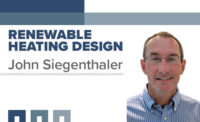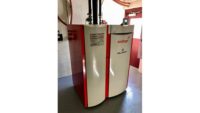Fuel oil and propane are the two most commonly available fossil fuels used for space heating in many rural and semi-rural areas of the country.
The cost of these fuels has dramatically risen over the past several years. In particular, the harsh winter of 2013-14 created an unprecedented spike in propane prices and availability.
This price volatility, combined with interest in environmental stewardship and the preferences to keep dollars spent on energy within local economies, has significantly stoked more interest in use of wood-based biomass fuels. This is especially true in the Northeast, which has abundant forest reserves and cold winter climates.
Please pass the pellets
There are several types of boilers that can burn wood-based fuels, including two-stage wood-gasification boilers, wood-chip boilers and pellet-fueled boilers. Of these, pellet-fuel boilers come closest to mimicking the fully automatic operation of oil- and gas-fired boilers.
Modern pellet units can automatically load their fuel, ignite it, regulate the combustion process, maintain their internal surfaces free of sustained flue gas condensation and even compress the small amount of ash they generate to lengthen time between ash removals. Several currently available pellet-fueled boilers are capable of modulating their heat output. Turndown ratios range from 3:1 to as high as 10:1. Modulation allows the boiler to better track the heating load as it changes.
Given these characteristics, it’s somewhat intuitive to assume that use of a pellet-fueled boiler simply is a matter of substituting a boiler that burns pellets for one that burns a conventional fuel. The process of selecting that boiler seems as simple as determining the peak heating load of the building, selecting a boiler with heat output capacity that at least equals the peak building load or more likely exceeds that load by a generous safety factor. Unfortunately, experience to date has shown this is a mistake.
Feedback from early adopters of pellet-fueled boilers, as well as conference presentations on operating experience with such boilers, indicates short-cycling is a common characteristic in systems that simply substitute a pellet-fueled boiler for a conventional unit.
Snapshot
Most heating systems are sized based on a “snapshot” condition. That condition, commonly referred to as “design load,” is the theoretical rate of heat loss from a building when the indoor temperature is at an assumed comfort condition such as 70° F and the outdoor temperature is at a value called the 97.5% or 99% design temperature.
The 97.5% design temperature for a given location is a value that the outdoor temperature is at or above 97.5% of the time during an average year. Viewed another way, the outdoor temperature is below the 97.5% design temperature only 2.5% of the time in an average year. The 99% design temperature is a similar concept, just a different (lower) value.
If one examines the “bin-temperature” data for a given location, it’s clear the outdoor temperature is significantly warmer than the design temperature much of the year. Figure 1 shows an example of bin-temperature data for Syracuse, N.Y.
Imagine a building in Syracuse with a design load of 100,000 Btu/hr., based on 70° F interior temperature and a 97.5% design temperature of 2° F. If the bin-temperature data is combined with this load information, another graph can be created that indicates the hours during which the heating load equals or exceeds the heat transfer rate shown on the vertical axis. An example of such a graph is shown in Figure 2.
Consider a boiler which has been sized to provide only 50% of the design heating load. The green area shown in Figure 3 represents the portion of the total seasonal heating energy that would be supplied by such a boiler.
This area is 84.2% of the total area under the red curve. The implication is that this boiler, which most designers would say is only half as big as necessary, could still supply about 84.2% of the total heating energy required over the entire heating season.
If the boiler was sized for 60% of the design heating load, the energy it supplies would be represented by the orange area in Figure 4. This boiler would supply 90.4% of the total seasonal heating energy requirement.
A similar analysis for a boiler sized to 75% of the design load indicates it would supply 96.3% of the total heating energy requirement.
What’s the point?
This type of partial-load analysis shows a boiler sized significantly smaller than the design heating load could still supply a high percentage of the needed total heat energy. It also implies a boiler sized to the design heating load – or that load plus a generous safety factor – will spend an extremely small amount of time operating at steady state conditions.
Automatically controlled, pellet-fuel boilers can take anywhere from 10 to 30 minutes to reach steady state operating conditions following an off period. The length of the warmup period depends on the water volume of the boiler relative to combustion rate and how cool the boiler water is when a call for boiler operation occurs.
Under partial load conditions, with limited modulation and without thermal storage, a boiler sized for design load often will turn off because it reaches a high-limit water temperature before it achieves combustion conditions that yield the highest efficiency and the lowest particulate emissions.
Although opinions vary on design requirement, many of those I’ve spoken to and who have worked extensively with pellet-fueled boilers, point to the following design “guidelines” for good pellet-fuel boiler performance:
- Don’t size the pellet boiler for design load. Instead, size a single pellet boiler for 60% to at most 75% of design load with the higher end being for a pellet boiler with wide modulation capabilities such as a 5:1 (or higher) turndown ratio. This allows the pellet boiler to supply “base load” heating, while leaving only 5% to 10% of the total seasonal heating energy to be supplied by an auxiliary heat source. In most systems that auxiliary heat source is a second boiler fueled by propane or fuel oil.
- Install thermal storage between the pellet-fueled boiler and load. That storage can range from 1 to 2 gal. of water per 1,000 Btu/hr., of the boiler’s full rated capacity. Thus, a pellet boiler rated at 60,000 Btu/hr., would be combined with 60 to 120 gal. of water storage. The upper end of this range (2 gal./1,000 Btu/hr.) is appropriate when the boiler has limited modulation or no modulation of heat output, the distribution system is highly zoned and has relatively low thermal mass. The lower end of the range (1 gal. per 1,000 Btu/hr.) is appropriate for systems having boilers with a wider modulation range, a high-mass distribution system such as a heated concrete slab operated with constant circulation and limited zoning.
Figure 5 shows one method in which a pellet-fired boiler could be combined with a conventional auxiliary boiler and a thermal storage tank.
The pellet fuel boiler and the auxiliary boiler are protected against sustained flue gas condensation by independently operated three-way thermostatic mixing valves. During a cold startup condition, the thermostatic mixing valve recirculates water leaving the pellet-fueled boiler back to the boiler’s return port. This allows the boiler temperature to quickly rise since no heat is “exiting” to the storage tank.
As the boiler inlet temperature rises above a threshold where sustained flue gas condensation would occur (typically 130 to 140° F), the three-way valve smoothly modulates to allow hot water flow to the thermal storage tank. The cool water returning from the lower portion of the tank is blended with hot water as necessary to maintain an acceptable boiler inlet temperature. The thermostatic mixing valve on the auxiliary boiler provides similar protection against lower entering water temperature.
Notice that the auxiliary boiler is piped so it interacts with the upper 25% of the buffer tank. This detail, in combination with thermal stratification, allows the upper portion of the thermal storage tank to serve as a buffering mass that protects the on/off auxiliary boiler against short cycling. This is especially useful in systems with extensively zoned distribution systems.
Temperature stratification within the tank, in combination with careful detailing such as horizontal piping connections carrying flow into the tank, minimizes thermal interaction with the lower portions of the thermal storage tank. The mass in the lower portion of the tank is not needed to buffer the auxiliary boiler, but can be used by the pellet-fired boiler.
When piped as shown in Figure 5, the thermal storage tank also serves as a hydraulic separator between the boiler circulators and the variable-speed distribution circulator.
It also is possible to use a motorized three-way mixing valve to protect a pellet-fueled boiler from low inlet water temperature. Many modern pellet-fueled boilers have internal controllers that can operate such a valve and eliminate the need for an external controller. Figure 6 shows the piping details.
Yet another method of protecting the pellet-fired boiler from low inlet water temperatures makes use of a variable-speed “shuttle pump” piped as shown in Figure 7.
The variable-speed shuttle circulator monitors the temperature of the water entering the pellet-fired boiler. When that temperature is low enough to create sustained flue gas condensation within the boiler, the shuttle circulator is either off or running at a very low speed.
Under such conditions, very little if any heat moves from the boiler into the thermal storage tank. As the inlet temperature to the boiler increases to or above a temperature at which flue gas condensation is no longer present, the shuttle circulator speeds up to transfer heat to the tank as fast as the boiler can produce that heat.
This method of boiler protection has been used in North America for systems that combine conventional boilers with low temperature loads for at least the past 20 years. It tends to be less expensive than motorized mixing valves in larger-capacity systems.
Restrain yourself
As primal as it feels to size a boiler to the design heating load of building, and perhaps even include a generous safety factor, this should not be done with pellet-fueled boilers.
A good target is to size for 60% of design heating load and use an auxiliary boiler as the “peaking” heat source when the system needs it on those exceptionally cold winter nights. An auxiliary boiler sized for 25 to 40% of design load also provides adequate capacity to handle the heating load under most conditions if the pellet-fueled boiler is offline for maintenance.
This “hybrid” approach will reward you with reliable heat delivery, high combustion efficiency and low particulate emissions. These all are vital to widespread acceptance of pellet-fueled boilers in North America.









